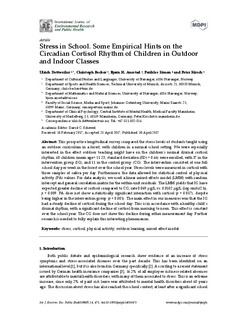| dc.contributor.author | Dettweiler, Ulrich | |
| dc.contributor.author | Becker, Christoph | |
| dc.contributor.author | Auestad, Bjørn Henrik | |
| dc.contributor.author | Simon, Perikles | |
| dc.contributor.author | Kirsch, Peter | |
| dc.date.accessioned | 2017-05-22T08:23:30Z | |
| dc.date.available | 2017-05-22T08:23:30Z | |
| dc.date.created | 2017-05-07T21:56:59Z | |
| dc.date.issued | 2017-04 | |
| dc.identifier.citation | Dettweiler, U. et al. (2017) Stress in School. Some Empirical Hints on the Circadian Cortisol of Children in Outdoor and Indoor Classes. International Journal of Environmental Research and Public Health, 14(475) | nb_NO |
| dc.identifier.issn | 1660-4601 | |
| dc.identifier.uri | http://hdl.handle.net/11250/2443078 | |
| dc.description.abstract | This prospective longitudinal survey compared the stress levels of students taught using an outdoor curriculum in a forest, with children in a normal school setting. We were especially interested in the effect outdoor teaching might have on the children’s normal diurnal cortisol rhythm. 48 children (mean age = 11.23; standard deviation (SD) = 0.46) were enrolled, with 37 in the intervention group (IG), and 11 in the control group (CG). The intervention consisted of one full school day per week in the forest over the school year. Stress levels were measured in cortisol with three samples of saliva per day. Furthermore, the data allowed for statistical control of physical activity (PA) values. For data analysis, we used a linear mixed-effects model (LMM) with random intercept and general correlation matrix for the within-unit residuals. The LMM yields that IG have expected greater decline of cortisol compared to CG; rate 0.069 μg/L vs. 0.0102 μg/L (log-units/2 h), p = 0.009. PA does not show a statistically significant interaction with cortisol (p = 0.857), despite being higher in the intervention group (p < 0.001). The main effect in our measures was that the IG had a steady decline of cortisol during the school day. This is in accordance with a healthy child’s diurnal rhythm, with a significant decline of cortisol from morning to noon. This effect is constant over the school year. The CG does not show this decline during either measurement day. Further research is needed to fully explain this interesting phenomenon. | nb_NO |
| dc.language.iso | eng | nb_NO |
| dc.publisher | MDPI | nb_NO |
| dc.rights | Navngivelse 4.0 Internasjonal | * |
| dc.rights.uri | http://creativecommons.org/licenses/by/4.0/deed.no | * |
| dc.subject | folkehelse | nb_NO |
| dc.subject | public health | nb_NO |
| dc.subject | stress | nb_NO |
| dc.subject | kortisol | nb_NO |
| dc.subject | physical activity | nb_NO |
| dc.subject | fysisk aktivitet | nb_NO |
| dc.subject | outdoor learning | nb_NO |
| dc.subject | mixed effect model | nb_NO |
| dc.title | Stress in School. Some Empirical Hints on the Circadian Cortisol of Children in Outdoor and Indoor Classes | nb_NO |
| dc.type | Journal article | nb_NO |
| dc.type | Peer reviewed | nb_NO |
| dc.description.version | publishedVersion | |
| dc.rights.holder | © 2017 by the authors. | nb_NO |
| dc.subject.nsi | VDP::Medisinske Fag: 700::Helsefag: 800::Samfunnsmedisin, sosialmedisin: 801 | nb_NO |
| dc.source.volume | 14 | nb_NO |
| dc.source.journal | International Journal of Environmental Research and Public Health | nb_NO |
| dc.source.issue | 475 | nb_NO |
| dc.identifier.doi | 10.3390/ijerph14050475 | |
| dc.identifier.cristin | 1468658 | |
| cristin.unitcode | 217,6,2,0 | |
| cristin.unitcode | 217,8,2,0 | |
| cristin.unitname | Institutt for kultur- og språkvitenskap | |
| cristin.unitname | Institutt for matematikk og naturvitenskap | |
| cristin.ispublished | true | |
| cristin.fulltext | original | |
| cristin.qualitycode | 1 | |

